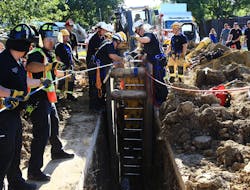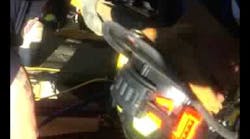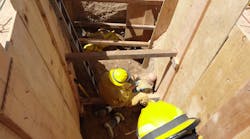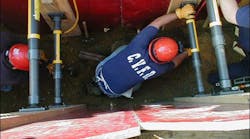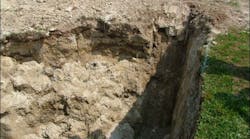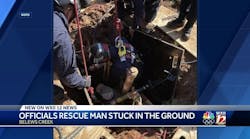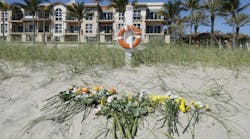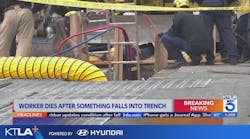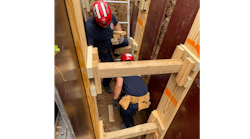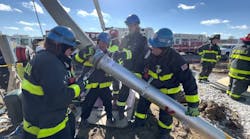The Irving, TX, Fire Department (IFD) is a 318-member career organization that serves the Dallas suburb, with a population of approximately 230,000. Irving is a mixed bag of occupancies from small residential neighborhoods to large commercial areas, high office buildings and hotels. The IFD has 11 fire stations, housing 11 three-person engine companies, 4 three-person truck companies, and 9 advanced life support ambulances (medics). In addition, the department staffs a hazardous material response team, swift water rescue team, and a technical rescue team. The department is divided into two battalions with a staffing level of 68 members per shift.
On May 5, 2016, at 2:43 p.m., IFD responded to an incident that was first dispatched as an “injured person” with Engine 4 and Medic 4 responding to the call. The temperature was approximately 83 degrees F and it was sunny, with 60 percent humidity and a light breeze. The incident took place in a residential area as a subcontractor for the city was replacing a sewer line in the area of 2110 Ridgewood Street. The city crew had dug a trench approximately 4 feet wide by 30 feet long through the concrete roadway. The trench ran in an east-west direction in line with the roadway. An excavator was straddling the trench just west of the patient, with the bucket positioned to the north side of the trench, in the area where the collapse had occurred.
As additional information was obtained, dispatchers determined this would be a trench collapse, with one patient trapped. The alarm office updated Engine 4 and Medic 4 and added the following resources to the call: the department EMS supervisor (520), Battalion 1, Engine 6, Medic 6 and Rescue 6. The three units from Station 6 make up the department's technical rescue team (TRT).
Arrival and size-up
Engine 4 Capt. John Hope assumed command. He immediately gave an initial size up of a "man in a trench approximately 10 feet below grade, buried up to his waist." Command reported that the patient was conscious and struggling to self-extricate. Hope reported that there were several coworkers still in the trench attempting to dig him out. These coworkers had already uncovered the patient to his waist. The patient had been initially completely covered with dirt upon trench collapse. Hope immediately directed these individuals to exit the trench, however, he had to request the assistance of law enforcement on location to gain compliance from the coworkers. Hope established a hot zone around the trench and denied entry to anyone other than rescue personnel.
Upon hearing the size up from Hope, Engine 6 officer Capt. Paul Harris requested the alarm office to have the TRT support trailer with additional shoring materials brought to the location. Harris requested that the alarm office also contact Coppell Fire Department for assistance from their TRT.
Arriving at the scene, Harris conferred with command and performed a size-up of the situation. Battalion 1 Chief Kyle Rohr arrived shortly after and assumed Command. He then assigned Harris to be the Rescue Division officer, and requested additional personnel. Command also requested CareFlight for helicopter transport. A landing zone was set up at a nearby elementary school playground and an engine company was assigned to establish the landing zone.
Hope was assigned to Logistics and directed the staging of equipment and supplies. The department’s training division brought the TRT support trailer to the location along with 11 probationary firefighters. These firefighters were assigned to the logistics division and worked to transport tools and supplies to the staging area. If these members had not been available, it would have been necessary to have additional companies assigned.
Making contact with the patient
After evaluating the situation, Rescue Division assigned a member to TRT Safety. The Safety member evaluated the scene and marked safety "no-go zones" with orange marker paint. The primary "no-go zone" was on the north side of the trench immediately above and behind the patient. This was an area about three feet deep by six feet wide that had collapsed into the trench and covered the patient. There was a steel "trench box" about six feet east of the patient.
A roof ladder was set in the trench box for entrance and evacuation should the need arise. Rescue assigned two TRT technicians from Medic 6 to enter the trench box to evaluate the situation and establish contact with the patient. The TRT technicians reported that the patient was conscious but he was combative and they were having difficulty communicating with him due to language barriers. One of the technicians spoke Spanish and was able to calm the patient somewhat. Positive pressure ventilation was set up using a Nano fan and hose.
EMS Supervisor Lt. Rodney Vike was assigned as the overall safety officer and worked with the TRT Safety officer to track team member work periods and establish rehabilitation with medical evaluation.
The position of the excavator bucket provided challenges in the setting of strong backs. In addition, as with all below-grade rescues, air quality can be a concern. The TRT Safety officer began air monitoring and continued throughout the incident. The trench was also evaluated for other hazards such as biological, electrical or hazardous materials; none were involved in this incident.
Developing an incident action plan
The Rescue Division concluded that this would be a long duration incident and notified Command. Medic 1 and Medic 11 were dispatched to bring additional TRT technicians—bringing eight TRT technicians to the location.
Rescue Division met with TRT team members and formulated an action plan to place two strong backs (4-by-8-foot sheets of durable plywood called fin form, held against the trench walls with struts) into the trench to provide a safe zone around the patient and a rescue technician. Coppell TRT arrived and were briefed by the Rescue Division. Two strong back teams were assigned along with members to lower struts into place. The TRT techs that had entered the trench box helped guide and place these struts.
Once the first set of strong backs were in place, one of the techs was able to access the patient for evaluation. The patient was found to be stable, but still very combative. It was unclear if the patient had a head injury or was just panicking. The decision was made to administer 100 mcg of Fentanyl intranasal to calm the patient; this was only moderately effective, so the decision was made to restrain the patient's hands using webbing rigged as wrist cuffs, controlled from outside the trench, to prevent him from harming himself or the rescuers.
Rescue crews started as two-person teams and evolved to three-person teams. These teams were rotated on a 15-minute cycle at first, but after several hours the time was reduced to a 10-minute work period with a 20- to 30-minute rest periods between. The rescuers were sent to rehab for hydration provided by the Irving Citizens Fire Academy Alumni Association and medical evaluations. By the time the decision was made to cut the work period down to 10 minutes due to fatigue of the rescuers, the patient had been uncovered down to about mid-thigh. Based on this information, Rescue Division met with Command and requested mutual aid from Dallas Fire-Rescue for their Urban Search and Rescue team to provide additional rescuers.
Progress slowed
Progress was slow due to the consistency of the soil, which was primarily damp compacted clay. Because of limited space, the primary tools used to remove the soil were sharp shooters, trenching tools, and gardening spades. Additional strong backs were set to provide a larger work space so more rescuers could be used. The excavator bucket was directly in line with the location where the struts needed to be placed. There was concern that if the bucket was moved, a secondary collapse could occur, so the decision was made to leave the bucket in place and place struts directly against the bucket.
While rescue efforts continued, the patient was frequently monitored and reports given to the Rescue Division officer by crews that had rotated out of the trench. Once the patient’s groin area was uncovered, the RIT Con-Space Rescue Harness was applied to see if it, in conjunction with a simple haul system, could be used to free the patient. The Rescue harness was applied, but the patient could not be extricated.
Vacuum truck called to remove debris
After conferring with rescuers, the Rescue Division decided to use the Irving Water Department’s large vacuum truck to remove the soil as it was broken loose by the crews. This truck is normally used to clear large debris from storm drains, etc. The rescuers used the vacuum truck to remove the soil after they broke it loose by forcing the sharp shooter shovels into the soil and twisting. After about five minutes, the truck had to be shut down to clear the soil that had blocked the hose. While this blockage was being cleared, rescuers notified the Rescue Division that this method was working and they would be able to remove the patient shortly if they could return the truck to operation. It took about five minutes to clear the blockage and the vacuum truck’s hose was lowered back into the trench.
Approximately 30 minutes later, the rescue technicians were advised to discontinue the vacuum and remove the hose. (At that point, Dallas Fire Rescue was canceled.) A simple haul system was used and the patient was extricated up from the soil. As soon as the patient was freed, he was lowered and secured onto a backboard. Two additional haul lines were attached to the backboard and the patient was removed via backboard from the trench using a ground ladder as a slide.
The patient was loaded into a waiting Irving medic unit and was evaluated by IFD paramedics and CareFlight personnel. He was transferred to the CareFlight helicopter and flown to Parkland Memorial Hospital in Dallas for treatment.
Lessons learned
- Real trenches are not like training trenches—the size of this trench, the position of the excavator bucket and the composition of the soil made the use of whalers inappropriate. The use of hand tools and frequent rotations of crews made the rescue possible. It quickly became a labor intensive effort. As we have seen, these types of incidents require multiple crews and even though the weather was fairly pleasant, all of the rescuers where very fatigued by the conclusion. Things would have been even more difficult in extreme weather conditions. These problems had to be overcome while maintaining a safe rescue environment.
- Continuing education and frequent drills are necessary for TRT technicians—these incidents are low frequency, high risk, and there is no replacement for hands-on training. Training with mutual aid companies should be encouraged. Frequent training with other agencies should be used to promote working together, sharing techniques, and gaining confidence in their combined efforts. The old saying "Practicing like we play leads to playing like we practice” has never been a more true concept than in a situation like this one.
- Use all resources available—the vacuum truck increased our effectiveness greatly. Having a working relationship with the water department allowed this unconventional use of their equipment to extricate the patient more rapidly than hauling dirt out by hand.
- Rescuers should be assigned to dedicated work groups—this will assist with tracking work and rest periods as well as accountability and prevent freelancing, creating possibly more victims. Rested workers will be more effective and less likely to be hurt during the incident.
- Call for help early, and call for a lot of it.
In sum
In closing, this was a successful rescue. The patient was released from the hospital with no long-lasting injuries.
All members involved in this incident can be proud of the outcome of this incident, including members of the alarm office, first-due companies, command staff, the training division, Irving Citizens Fire Academy Alumni Association, Irving Water Department and both TRT teams from Irving and Coppell.
Trench Collapse Resources
- Freeman: The Progression of Trench Rescue Operations
- Daley: First Due At A Trench Rescue
- Daley: Rescue Operations for Trench Collapse - Part 1
- Daley: Rescue Operations for Trench Collapse - Part 2
- The Buzz on Technical Rescue: Crush Syndrome and Injuries from Rescue Incidents
PAUL HARRIS, EMT-P, is a captain with the Irving, TX, Fire Department, where he has served for 35 years. Harris is trained in rope rescue, confined space rescue, trench rescue and structural collapse. He is currently assigned to the department's Technical Rescue Team at Station 6. In addition to serving with the Irving Fire Department, he serves with Texas Task Force II as a search team manager.
